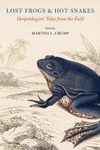![Notes on a Herpetological collection from the Somali Republic Notes on a Herpetological collection from the Somali Republic]()
Click to have a closer look
About this book
Contents
Customer reviews
Related titles
About this book
Language: English
This publication reports on the results of a collecting trip made by the authors in the Somali Republic during July and August 1961, during which 1300 specimens were collected. The trip was initiated with the aim of obtaining examples of and making observations on the three endemic Somali species of amphisbaenids, but examples of many other groups were also collected. Mammals were deposited in the American Museum of Natural History, birds in the Buffalo Museum of Science, molluscs, arthropods, reptiles and amphibians in the Museum of Comparative Zoology, Musée Royal de l'Afrique Centrale, and Carnegie Museum. Materials of various groups were turned over to specialists. It also seems logical to include in the discussion notes on a small but interesting series of specimens collected by Mr. C. F. Hemming of the Desert Locust Survey, Somali Republic.
It is the purpose of these reports to provide and comment on new information regarding biology, ranges and variation of the amphibians and reptiles of the Somali Republic, and to furnish a record of localities for the recipients of collections of other kinds of animals. Major taxonomic discussions have been avoided as unjustified in regional studies at the present level of our knowledge of most of the African herpetofauna. Much revisionary work is needed before local collections may be determined accurately. It may not be amiss to point out that materials adequate for the solution of many taxonomic problems may well be already available. What is needed is a collation and review of specimens scattered in the museums of three continents.
The authors have generally listed recent papers dealing with a cited form, as well as the basis of their determination. This should yield a key to their reasoning and permit evaluation of the identifications.
A conservative line has been taken on trinominals. In the case of many wide-ranging African species, the use of trinominals has historically amounted to the naming of the locally available samples from disjunct areas, and there has been little effort to assemble specimens from more than a few museums, in order to approach a continuous representation on the basis of adequate samples. Trinominals have been used in these papers where the characteristics of the materials fall into the range of described races. Material furnishing the basis for recognition of a new race has been pointed out. However, when review of the literature and examination of specimens required the review of much mainly non-Somali material, this has been pointed out and the binominal retained without regard for non-Somali subspecies.
Specimens are listed in order of localities from south to north. In citation the locality name is followed by the collecting date and the museum number(s) in that order. Unless otherwise indicated the specimens were collected by C. Gans, and the ecological and life history notes and those on color of living specimens are taken from his field notes.
Contents
- Introduction and itinerary (C. Gans) 1
- Frogs and turtles (R.F Laurent) 15
- Lizards (R.F. Laurent and C. Gans) 25
- Snakes (C. Gans and R.F. Laurent) 47
- The Amphisbaenian genus Agamodon Peters (C. Gans and H. Pandit) 71
- Literature cited 87
- Plates
Customer Reviews






















![Révision des Characidae Nains Africains [Revision of African Dwarf Characidae]](http://mediacdn.nhbs.com/jackets/jackets_resizer_medium/14/148604.jpg?height=150&width=99)

![Les Poissons du Lac Tumba et de la Région d'Ikela: Etude Systématique et Écologique [The Fish of Lake Tumba and the Ikela Region: Systematic and Ecological Study]](http://mediacdn.nhbs.com/jackets/jackets_resizer_medium/14/148546.jpg?height=150&width=100)
![Faune des Poissons d'Eaux Douces de la Réserve de la Biosphère de Dimonika (Mayombe, Congo) [Fauna of the Freshwater Fishes of the Dimonika Biosphere Reserve (Mayombe, Congo)]](http://mediacdn.nhbs.com/jackets/jackets_resizer_medium/14/148793.jpg?height=150&width=107)


















![Les Poissons des Hauts-Bassins de la Volta [The Fish of the Upper Basin of the Volta]](http://mediacdn.nhbs.com/jackets/jackets_resizer_medium/14/148583.jpg?height=150&width=99)
![Tshopo: Laborieuse Construction Politico-Administrative Coloniale Muée en Bastion du Nationalisme Congolais [Tshopo: Laborious Colonial Politico-Administrative Construction Turned into a Bastion of Congolese Nationalism]](http://mediacdn.nhbs.com/jackets/jackets_resizer_medium/25/254480.jpg?height=150&width=106)



